On the Table: Dinner with Frank Jacobus, Marc Manack, E.B. Min, & Jeffrey L. Day
Frank Jacobus, Marc Manack, E.B. Min, and Jeffrey Day join designers and critics to discuss partnerships, regions, and regionalisms.
November 30, 2016

Guests gathered following lectures by 2016 Emerging Voices Frank Jacobus and Marc Manack of SILO AR+D and E.B. Min and Jeffrey Day of Min | Day.
The League’s annual Emerging Voices program recognizes eight firms with distinct design voices, each invited to lecture during the months of March and April. Following each night of lectures, the evening’s two presenting firms were joined at dinner by prominent architects, critics, and others in the field for informal and lively conversation.
In the following conversation (which has been edited and condensed), Frank Jacobus and Marc Manack of SILO AR+D; and E.B. Min and Jeffrey Day of Min | Day, and dinner guests discuss partnerships, regions, and regionalisms.
Billie Tsien, Tod Williams Billie Tsien Architects: It was interesting to me that all of you talked about partnership during your presentations. I understand the partnership when you’re married, but the business partnership is somewhat mysterious. What was the biggest argument you ever had and how did it end?
Frank Jacobus, SILO AR+D: To answer the first part of that question, Marc and I are basically married. We probably see each other more than we see our spouses. To answer the second part of your question, if you get to know Marc, you know that he has a very big personality. If there’s ever an argument, Marc automatically wins. So there has never been a moment when we had a major disagreement or a falling out. And we’ve been at this for about three or four years now.
E.B. Min, Min | Day: Frank and Marc are still in the honeymoon phase.
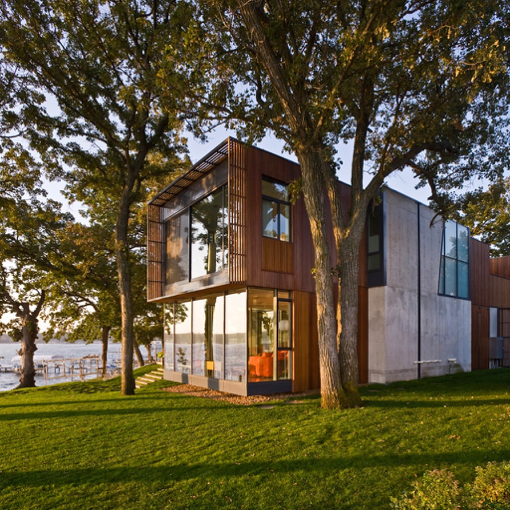
House on Lake Okoboji by Min | Day. Photograph by Paul Crosby. Courtesy of the architects.
Jeffrey Day, Min | Day: E.B. and I met in 1990 while in graduate school. So, we’ve known each other for a long time, and we have been business partners since we started our practice in 2003.
Min: But I like to joke that we wouldn’t be partners if we worked in the same city. We have an office in Omaha, Nebraska and another in San Francisco. For us, it works to have a long distance relationship. We don’t really have large arguments about one thing, rather we have ongoing arguments about who is supposed to do what and who is doing his or her fair share – just like any other domestic relationship. I think we experience a lot of the same issues that married couples experience, to be fair.

Conceptual design diagrams by SILO AR+D take the form of equations. Image courtesy of the architects.
Marc Manack, SILO AR+D: Frank and I recently took the Myers-Briggs Type Indicator Test and shared our results with each other. To our surprise, we are complete opposites.
Jacobus: I am INFP.
Manack: And I am ENTP. So, I am the extrovert, and Frank is the introvert, and on and on and on. I started taking personality tests at a really young age, which I admit is weird, but I have always been fascinated by them. My results have never changed since I was 11, and Frank had never taken one before. Though we’re both analytical (which I think most architects are), it was sort of strange to see that we’re so opposite. Our interests and what we like to do in architecture also differ. I hope all of these qualities will make our partnership sustainable.
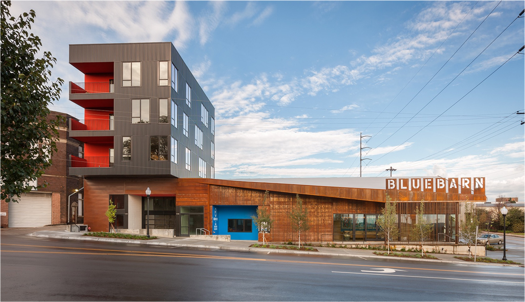

The Blue Barn Theater interior (below) and its exterior with the adjacent Boxcar 10 project (above) by Min | Day. Photographs by Paul Crosby. Courtesy of the architects.
Rosalie Genevro, The Architectural League: Both SILO AR+D and Min | Day have two offices in different parts of the country. Can you talk about regionalism and why you specifically called it out in your lectures as something you don’t want attached to your work?
Manack: Well, I think the legacy of romantic regionalism is really banal – it falls intro tropes about vernacular forms and a certain kind of folksy attitude about place. To me, these ideas quickly devolve into a sort of mysticism that surrounds practices operating in a regionalist space. And we all know who they are. We’ve learned a lot from Marlon Blackwell – he always talks about his work as attached to place. But we’re trying to convince him that he’s a complete postmodernist. Marlon often talks about trailers and different kinds of vernacular types, but I don’t think those are his principle interests in architecture. He’s really fascinated by facades and flatness and erasing materiality. And when he started in architecture, he was looking at Charles Moore and that school of thought. With all of this in mind, Frank and I think that regionalism ignores a lot of issues in architecture and we look for more comprehensive ways of describing our practice. We’re not really sentimental about the building culture of Cleveland or the building culture of Arkansas.
Jacobus: I would also add that Marc and I deeply care about context. We talk about context with every project – we care where the site is, we care about the nature of the place. But we don’t want to be bound by a notion of what has come before in a particular place. For example, I look at the Japanese modernists now and think what’s going on in Japan is incredible. Why can’t modernist architecture in Japan be an inspiration for our work in Fayetteville? Why be limited by forms that have come before? We want to appreciate and understand context very much, but that doesn’t mean we have to embody the forms that came before – if that’s what you mean by regionalism.
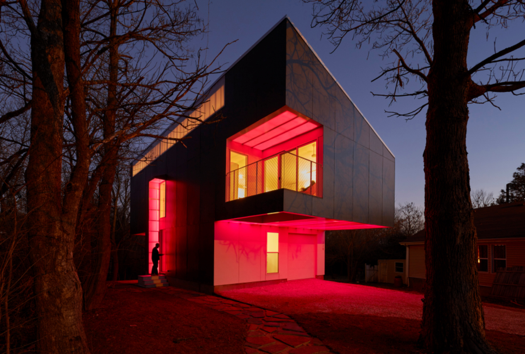
A system of LED lights allows the Mood Ring House by SILO AR+D to change color. Photograph © Timothy Hursley.
Courtesy of the architects.
Lyn Rice, Rice+Lipka Architects: I tend to agree with you. And I’m originally from Oklahoma by the way, so I have a kind of envy for your practices. I moved to New York City and wonder how my work would be different had I stayed in Oklahoma. But look at the current show at MoMA, A Japanese Constellation: Toyo Ito, SANAA, and Beyond, for example – it’s really inspirational. There’s something cohesive about the work in the exhibition that one could argue is a kind of regional response to architecture, when such a small group of architects can influence other practices so much.
Jacobus: But is that happening serendipitously or overtly? There are certain influences that come from a place, but there’s also a culture being built in that place. What would you say is the regionalism of architecture in New York City?
Rice: Renovation work?
Martin Finio, Christoff:Finio Architecture: I can understand why you would feel so defensive about being defined as a regionalist architect, but I think it’s probably the best thing you have going for you. And I would not try to brush that off. The world does not need more New York City architects. I think SILO AR+D and Min | Day were selected as Emerging Voices because you see the world differently.
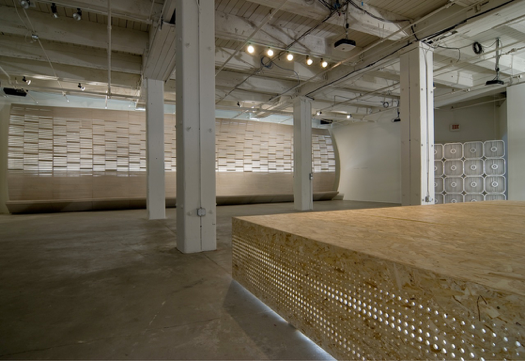
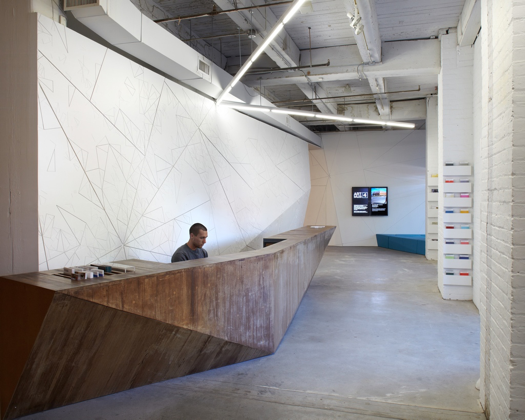
Interior views of the InfoShop (below) and Soft Cube (above) at the Bemis Center for Contemporary Art by Min | Day. Photographs by M. Sinclair. Courtesy of the architects.
Day: For us, I think the difference is that we’re not regionalists in the sense that we focus on our regions. I think we are called regionalists because we operate outside of major centers of architecture. But I would also consider myself a recovering regionalist. At Berkeley, I studied with all the hardcore “critical regionalists,” like Richard Fernau, Daniel Solomon, Donlyn Lyndon, and others who drew upon the Bay Area Tradition of previous generations. I received the Branner Fellowship specifically to study regional cultures. I traveled all around Tibet to understand how particular building traditions change at political and geographic borders. I think it’s a matter of understanding and recognizing that there are differences produced by a range of factors. To return to the examples of Toyo Ito, SANAA, Sou Fujimoto, and others, I believe the phenomenon is not so much where they are located, but rather that there is a group of people engaged in conversation through their work.
Astrid Lipka, Rice+Lipka Architects: It’s no coincidence that they are in Japan. There is specificity to the way the Japanese live, and a very different use of small spaces. I don’t think it would work here in the United States. Regionalism is often understood as backward looking, but I think regionalism is more interesting as a tool to observe what is emerging. In Japan, architecture is addressing contemporary issues – it’s contemporary architecture after all – but it also has an embedded history.
Jacobus: I totally agree with that, Astrid. Maybe there is a sort of unintentional regionalism. We don’t deny the influence of architect Fay Jones. We don’t deny the influence of Marlon and others around us. But we don’t overtly seek out their work as our precedents.
Karrie Jacobs, Architect Magazine: Isn’t regionalism always unintentional to some extent?
Manack: No, I don’t think so.
Jacobs: I can think of some examples of subconscious regionalism. Lake | Flato has very successfully embraced their regional context and extrapolated from it. But I think to some extent regionalism is not a conscious choice.
Manack: I think regionalism is a very conscious choice. It’s an issue of style. I’ve always been surprised by architects who claim to be regionalists – their work looks the same everywhere else in the world.
Jacobs: Do you think the work of regionalists from a given geographic region looks similar to other regionalists around the world?
Manack: Yes. If you look at practices like Lake | Flato and Bohlin Cywinski Jackson, you can create vectors through their work, like a similar sense of detail, a certain material palette, and a very clear style. When you look at Japanese architecture, it’s white, it’s light, it’s filigreed, and it’s very open. It has a weight to it that isn’t found in other places. Japanese architects are cultivating a very clear aesthetic trajectory in their work. But for us, regionalist work, at least in our part of the world, looks a certain way.

Reflects by SILO AR+D is a treeless treehouse. Photographs courtesy of the architects.
Min: One of the issues here is the definition of regionalism. I think we’re conflating regionalism as an aesthetic when I don’t think that was the intention. Marc, when you equate the work of Bohlin Cywinski Jackson and Lake | Flato, you expose a certain kind of nostalgia regarding tectonics: you can see how the building is made. There is a kind of aesthetic there, but I think this is not the kind of regionalism you are talking about.
Jacobs: Well, there’s regional and there’s regionalism. And regional may describe the honest product of a set of circumstances, conditions, and a culture, while regionalism may refer to a self-conscious response to all of those, or a self-conscious synthesis.
Genevro: For me, regionalism is about a sense of connection to a natural place, which I think deserves a higher level of importance over vernacular form. It’s possible to make the argument that some of the most influential architects of the older generation – and no value judgment on their work – actually had a specific relationship to a place that informed their work, which then played out elsewhere (Renzo Piano because of Genoa, Frank Gehry because of Los Angeles, and even Louis Kahn because of Philadelphia). Nobody calls them regionalists, but I think the relationship of a creator to a place is a very valid and valuable thing.
John Hartmann, Freecell Architecture: Maybe we should use the term chronologists. With regionalist, you think of place before time. But what if we reverse that order and look to time first, and then place? We collectively work together, even if we’re all in different places and different cities. Maybe we should focus more about the systems, the methods, and the contemporary concerns that we have, and less about where we’re located.
Manack: When you work in places like we work and come from places like we come from, you have to pay attention to the full spectrum of issues in design. You can’t ignore the needs of the client. You really have to be engaged in everything. We’re working with such low means and such high aspirations at the same time – it’s a curious kind of condition.
Jacobus: We embrace the people who we’re around and the work that we see and we talk about it a lot. But we now have access to all of this other great work. I see it with my students, too. When I was younger, we had very particular people whose work we studied, and now our own students are looking at so much more of what is out there. It feels like we’re in this age of friction where we long for a regional identity but we’re engaged in the world in a global way. I’m sensitive to the work that has happened before us in Fayetteville, for instance, but I also love what’s happening in other places and how that work could be adapted to where we live.

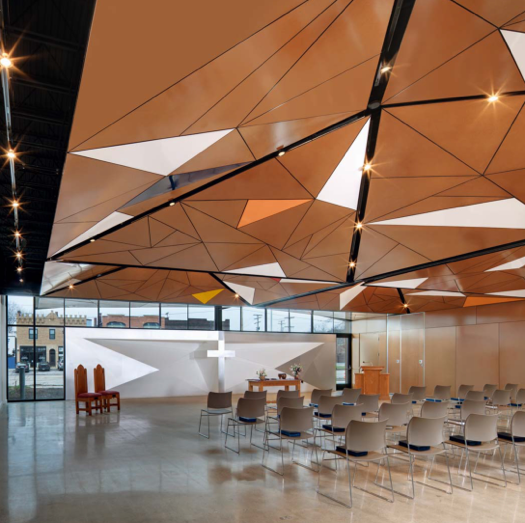
North Presbyterian Church by SILO AR+D. Photographs © Pease Photography. Courtesy of the architects.
Michael Bell, Bell-Seong Architects: There is also a constellation of architecture schools in the United States and around the world, which I think everybody here is a part of to some degree. This network of architecture schools has literal geographic place and also has different kinds of local academic heroes. There’s the question regarding the kind of academic economy that distributes us, but there’s the other kind of economy that distributes everyone and everything else. I think the tension between these has to be acknowledged. I mean, would you be where you are today without a professorship at a school of architecture? Maybe not, I don’t know. I think there is a kind of mercenary colonialism or missionary-ism tied to this constellation of architecture schools and the architects that come with that network. I thought your idea to turn a quasi–strip mall into a church was brilliant in that regard. The church becomes regionalist to me when you can look at the altar through its storefront. As severe as that sounds, it revealed that place in much of the United States is indeed often a form of universal and commodity-driven building systems. That seems very different than the more “architecturally” universal tessellated ceiling, which could be found in any architecture school – the storefront was a universal commodity; the tessellated ceiling is universal to architecture schools and in some way regional to our community but not a geographic place. There are two less-than-local aspects to the work here. I used to practice in Houston – where I also taught at Rice University – and these issues of an academic constellation of references versus local context were very much on everyone’s minds even when the local context was a massive market-driven city.

A component of the Art Farm / Red Barn Gallery project by Min | Day required the relocation of a barn. Photo courtesy of the architects.
Min: I think Jeff and I need to be more careful about how we talk about our work, because Martin suggested that we’re being defensive about the regionalist claim. It is making me think quite a bit. We have work in areas that are considered second tier, but I’m from San Francisco, which considers itself a premier city in California. Los Angeles could care less about us, but there’s always this wariness toward being considered a second-tier area.
Jacobs: A very San Francisco thing to think!
Min: I know! But I think there’s some play in that. Some people have a tendency to fly over the country and look at our work and say “Oh, it’s good for the middle of the country,” or “It’s exotic because look at what you’re doing on these farms” without fully understanding our intentions. I think we are often pigeonholed because we have work on farms and in other rural spaces that you don’t see in urban areas. Being based in San Francisco, I appreciate our work outside of the city and our identity as more than just a San Francisco office. There are only so many tools and solutions that can be used for infill projects, so we love to explore and experiment with what we can do in place of a bay window. But we owe a huge debt to Bay Area modernism and other Bay Area traditions. I think we’re trying to achieve the right balance between being products of our regions and transcending those regions.
Manack: I think that’s true. A lot of regional architects become novelty acts or are sort of noble savages and we’re not so interested in that.
Tsien: There’s something very important about work that’s done in a place where nobody’s looking. And I think that’s potentially some of the most important work. Last night, in Alejandro Aravena’s acceptance speech for the Pritzker Prize, he said that he was a little afraid – afraid that with all the attention he would have as a Pritzker winner, that he could gain power but also lose a lot of freedom. There is an intense observation of architects on the coasts because it’s so easy to see their work. In a way, it’s very much a kind of prison. There’s a freedom and maybe a stronger drive to find your own clarity when somebody is not constantly picking you apart. You are able to work, do what you think is right, and it’s yours.
Jacobs: It’s interesting you bring that up. When we launched Dwell magazine, people said to us “There aren’t enough houses. You’re never going to be able to publish enough houses because all of the good ones are taken.” My response to that was “Okay, we’re going to find houses in cities that are not New York or Los Angeles.” It was really hard to find those people at first, but we kept searching. It was an absolute pleasure finding these architects – they were building things in the way that they thought buildings should be built in places where people weren’t looking for good architecture.
Rice: A few years ago, we were up for an AIA award in New York City. There was a fellow from the Midwest leading the jury (because AIANY intentionally picks jurors from outside the city) and we were surprised to find out that the jury didn’t give any honor awards. At the awards event, one juror explained and said something like: “No one deserves an honor award. When we come to New York City, we all have higher expectations.” I think there was some kind of reverse regionalism going on there. I said to myself, “You think it’s better here in New York City? I mean, that somehow we have to hold a bigger stage?” I don’t think it’s true. It’s not any different here. There’s still the day-to-day effort and you try to do the best that you can do. There’s certainly more press here, but I’m not sure that you can achieve more here in New York City. I thought it was interesting that he had idealized expectations of us and we let him down.
Manack: Lyn, I think that’s just years of payback for New Yorkers coming to regional design or state design juries and saying the same thing to us. What goes around comes around.
